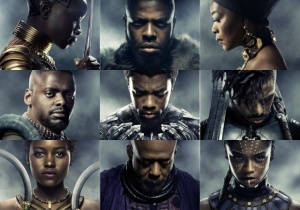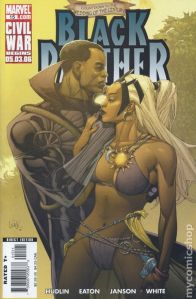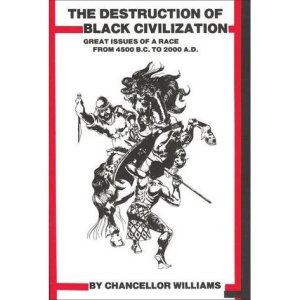“First, I need to tell you who I am,” is how Somali Canadian researcher Hodan Mohamed opens her response to Faisal Kutty’s critique of Black Panther (2018). Mohamed then demonstrates her qualifications to speak on both Islamophobia and anti-Blackness. She writes, “I am an educator, researcher with a focus on diversity and inclusion, curriculum development, public engagement, immigration, and Criminal Justice System working with underserved and underemployed Black youth in Toronto.” Like so many other Black women, Black Muslim women have to establish our credentials just to be taken seriously in any discussion. Black women experts are often dismissed by people who lack cultural competence or knowledge of the field. In this case, we should pay careful attention to the writings and thoughts of Black women. While much of my graduate work from 2004-2008 focused on colonial surveillance of Muslim communities in Northern Nigeria, as an African American Muslim I do not speak for Nigeria. But I hope to highlight important voices we should listen to in discussions on why Black Panther’s #BringBackOurGirls rescue operation was important and point to better ways at responding to our discomfort. The debate about Islamophobia in Black Panther highlights intra-Muslim racial power dynamics, where the Black Muslim issues and concerns are subsumed for the sake of a monolithic ummah.
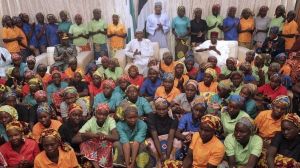
This picture was in 2017 featuring recently released Chibok girls meeting with President Buhari. Today, 100 of the Chibok girls remain missing.
Roughly half of Nigeria’s 186 million population are Muslim, and 40% Christian and 10% indigenous African faiths. According to a 2015 Pew study with the top 10 largest Muslim populations, Nigeria ranks the 5th ahead of Egypt. Nigeria’s Muslim population is largely concreted in the North of Nigeria. Boko Haram, whose name “Western education is forbidden,” brazen abducted of 276 girls from their school in the north eastern Nigerian town of Chibok. Obiageli Ezekwesili, former minister of Education in Nigeria and Vice President of the African Division of the World Banks founded Bring Back our Girls and according to the website, “. It spread to social media via the millions of Nigerians and Nigerian-Americans on twitter who were joined by social justice advocates all over the world.” It then went on to become one of the largest social media campaigns. Black Panther includes a brief scene where the soon to be crowned King of Wakanda, T’Challa extracts Nakia who is in on a spy mission in the Simbasa jungle where Boko Haram hides out. Daniel Oruba writes Black Panther executive producer, Nate Moore explains the purpose for the scene:
The notion that Wakanda exists, has all these resources, and is in Africa — a continent that is plagued by conflict of different kinds — we knew we wanted to tell a story of whether or not they’d feel a sense of responsibility.
And [missing Chibok girls] is a conflict that is unfortunately still ongoing. We wanted them to come face to face with a real thing.
We would have been cheapening what Wakanda meant if we didn’t tackle that, because this is a real thing that people should be aware of if they are not. We didn’t want to exploit it, we wanted to shine a light on it.
Nigerians of all faith were elated when the Black Panther paid homage to an issue that their nation was still grappling with.
https://twitter.com/OLU_MIghty007/status/967607935802146817
While Nigerians celebrated the inclusion of Boko Haram, some Muslims living in the West felt uncomfortable that a Muslim led insurgency was mentioned at all in the Box office record breaking film.
https://twitter.com/_nabintou/status/969197236419813376
Kutty writes, “The scene inadvertently reinforces what colonial studies experts such as University of Toronto Professor Sherene Razack call the stereotypes of the barbaric Muslim man, oppressed Muslim woman and imperilled non-Muslim.” Some people were upset that the kidnapper used wallah, a Hausa word and kefiyyas, something that Boko Haram members frequently wear. A Muslim chaplain Sami Aziz wrote in Medium that the film didn’t show the balanced portrayal of Muslims. However, one of the rescued offered Islamic prayers and said Allah. Others pointed to the rescued girls taking off their scarves. While girls threw off the large scarf but still wore small head coverings more akin to traditional clothing of the region.
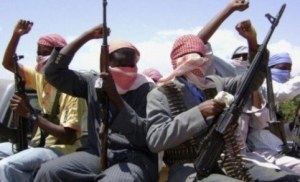
Real life Boko Haram Image source: http://urhobotoday.com/?p=13488
However, the response amongst some non-Black Muslims was pointedly different than that of Nigerians. For about a decade, a toxic ideology, disintegration of traditional Islamophic authority tied to indigenous African institutions, and collapse of the state has led to Boko Haram. The two minute scene explored sex trafficking and child soldiers, two war crimes that fuel groups like Boko Haram and the Lord’s Resistance Army (which was a warped version of Christianity). Asha Noor, a Somali American community organizer who works on Islamophobia in Michigan says:
It may not be the best depiction, but it is accurate. But in the movie, it was dealt with by Africans. That is the ideal way of how issues should be dealt with in Africa should be handled, rather intervention from outsiders. Now all these South Asians and Arabs complaining about the depiction about something that has happened and is happening. But they’ve been silent. You need to be the number one advocate for girls taken by Boko Haram.
What makes it even more tragic is that while the depiction of Muslims behaving badly embarasses us Muslims in the West, we are not uplifting the voices of Nigerians who have been affirmed or the stories of the victims of Boko Haram atrocities.
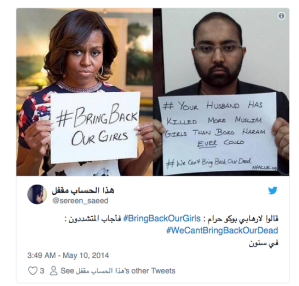
The Muslim derailing of Black Panther is reminiscent of 2014, when Middle Eastern activists derailed MIchelle Obama’s signal boost of the #BringBackOurGirls hashtag. Instead centering Black girls who were lost, Muslim twitter centered Pakistan, Yemen, and some threw in Somalia to be inclusive. Four years later, many of the girls haven’t found their way home. And just the week alone, 100 more school girls have been kidnapped. Likewise, our discomfort with negative depiction of Muslims keeps our communities from supporting local communities facing real and imminent threat.
This raises the question, what makes something Islamophobic? The Islamophobia Research & Documentation project explains that Islamophobia was was first introduced in 1991 to mean “unfounded hostility towards Muslims, and therefore fear or dislike of all or most Muslims.” The website provide a working definition:
Islamophobia is a contrived fear or prejudice fomented by the existing Eurocentric and Orientalist global power structure. It is directed at a perceived or real Muslim threat through the maintenance and extension of existing disparities in economic, political, social and cultural relations, while rationalizing the necessity to deploy violence as a tool to achieve “civilizational rehab” of the target communities (Muslim or otherwise). Islamophobia reintroduces and reaffirms a global racial structure through which resource distribution disparities are maintained and extended.
How are some films that depict conflict in Muslim communities Islamophobic and some not? Just because something makes us uncomfortable doesn’t make it Islamophobic. Like Hodan Mohamed, numerous Black Muslim thought leaders contend that the scene was not Islamophobic. The scene spoke to a real issue that is affecting communities in the region. Dawud Walid, who has been in the forefront of addressing Islamophobia in Michigan also shared his thoughts on the film,
https://twitter.com/DawudWalid/status/968401155368906752
Why are some non-Black Muslims focused on this aspect of the film, rather than centering Nigerian narratives or even the narrative of the film? Layla Poulos proposed, “Perhaps they couldn’t relate to all those Black bodies.” Asha Noor, the pointed out, “You don’t have them attacking other Marvel white centered films for their anti-Muslim depictions. They don’t see themselves in T’Challa, and they don’t aspire to be part of that. So all you have is critique. They just stress me out. I don’t have time for that.” Those arguing that the film is Islamophobic are pitting Black Muslims against their two identities. To watch the film, they have to wrestle with whether celebrating this moment is betraying their faith. It truly is exhausting when non-Black Muslims excercise their cultural capital to speak for all of us, and derail important conversations that Black Muslim should be having.

As Dawud Walid pointed out there was a lot of Islamic imagery, including homage to the great mosque of Djene. In Wakanda there were numerous representations of Muslim cultural identity including but not limited to Fulbe, Wolof, Tuareg, Hausa, and Mandinke. These included certain robes tied to Muslim clerical linages, Sahelian/Sudanese cultural elements including dress and architecture, pendants that many Africans wear that hold verses of the Qur’an,and names that evoke Muslim identities. Costume designer Ruther Carter highlights that the Tuareg were important in representing the merchant tribe. Some of these Muslim elements reflected in the Pan-African imagery of Wakanda go largely undetected by people unfamiliar with West African or Sudano/Sahelian cultures. Black Muslims showed up to the film wearing their traditional African garb, and they were welcomed and embraced by their kinfolk of all faiths.
Following the publication of the Kutty’s article and the viral social media post, some Muslims, mostly from South Asian and Middle Eastern heritage, said that they were boycotting the movie. I don’t think that my essay would sway them to watching the film. Nor is that necessarily my interest. What makes this tragic is that the Black Panther could do a great deal in uprooting anti-Blackness and starting difficult conversations in our faith community. It happens to be that Middle Eastern and South Asian Muslim communities have long histories of anti-Blackness, narratives and depictions that date back to trans-Saharan and Indian Ocean slave trade, which are now exacerbated by global white supremacy, and model minority narratives as strategies for assimilation in the West.
Kutty’s article didn’t reference Africanist scholars or even Northern Nigerian Muslims who would be directly impacted by the film. Had he done so, then perhaps his article would have opened up nuanced discussions about Islam in Africa, African Islam, and Black Orientalism. But to do that, one would have to dig a bit deeper, to do so would mean to recognize the rich 1400 years of Islam in Africa and the agency of Black Muslim voices in practicing and interpreting their faith. With a film on track to reach one billion in sales, as Muslims we are not seizing the opportunity to increase awareness about #BringBackOurGirls and even raise funds to support Boko Haram’s victims. Instead, we are arguing about how it makes Muslims look. This is stressful. It is tiring. And ain’t nobody got time for that.
I offer up a few to people who are not Black watching the film.
- Be humble and don’t argue. Especially with Black Muslims or Africans about the film. This is especially the case if your opinion is contested by scholars, organizers, activists and leaders whose work is on the front lines of addressing anti-Blackness and Islamophobia or they are Africanist scholars. When exploring the complexities of our multiple identities, Black Muslim voices should not be subsumed in service of a “monolithic” ummah. Within the framework of cultural competency, that is akin to cultural destructiveness.
- Evaluate your implicit bias. If your main take away was that one short scene where one group of bad guy may have perhaps claimed the same religion as you, maybe you need to explore some of your ability to relate to Black characters. One place to start is the Black-White implicit association test https://implicit.harvard.edu/ . If you’re not happy with the results, the test isn’t wrong. It means you have to do some work to interrupt that bias.
- Lean into the discomfort you feel in that film. De-center yourself and how your identity groups are depicted in the film. This may be the time when you have to explore where you identities are privileged and targeted. It may not be fun to recognize that your faith identity may be oppressive to other groups (i.e. women, religious minorities in Muslim majority societies, people whose societies were raided and traffic to fuel the trans-Saharan and Indian Ocean slave trade for 1400 years); It’s called intersectionality.
- Read #BlackMuslimReads. This would be the time to start exploring African scholarship on Orientalism, African Islam, and Islam in Africa. I offer up my bibliography on race and slavery in Muslim societies https://margariaziza.com/info-and-resources/race-and-slavery-in-muslim-societies-bibliography/. This would be the time to dive into the works of Black American scholars like Sherman Jackson, Dawud Walid, or Su’ad Abdul Khabeer who lare experts in Black orientalism to see if your take has some basis
- Get trained. Sign up for anti-racism training course. MuslimARC offers some to help provide you with some critical cultural competency and a shared language to understand many of the issues of power, cultural domination, and narrative shift. We hope you take this as an opportunity to begin a long journey of collective liberation.

